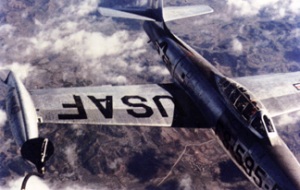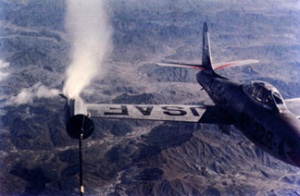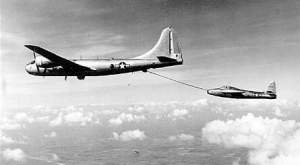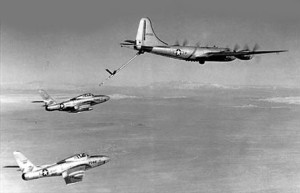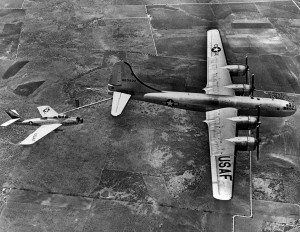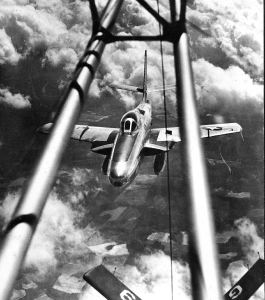Experimenting with jet refueling – Multiple F-84 refueling configurations
By the late 1940s and early 1950s, air refueling had been around in an experimental capacity for nearly 30 years. With the end of the Second World War and the inception of the Cold War, air refueling was seen as a vital technology that had to be further developed so that fuel hungry jet aircraft would have the range and endurance required to perform their required missions. The F-84 Thunderjet existed during this time of air refueling development and refinement; therefore it saw numerous configurations that included multiple drogue and receptacle variants. One of the more interesting configurations tested was a dual probe system that required the F-84 to refuel each of its wingtip mounted tanks with a separate probe that was integral to each tank. This highly offset design made it difficult for the receiver pilot to accurately make contact with the tanker’s drogue. The distance from aircraft centerline meant that the pilot would have to look sideways to align the probe with the drogue. During this time he would have to use his peripheral vision to fly formation off of the tanker. Complicating matters was the fact that any roll would be magnified at the wingtip.
Another drogue refueling method employed by later model F-84s was a single point refueling probe. The probe was located on the left side of the forward fuselage. This positioning made it much easier for the pilot to see the probe while still being able to fly formation off of the tanker. This design has proved to be the best positioning for refueling probes, and aircraft today still feature their probes in a similar position with respect to the pilot.
A third refueling system that can be found on the F-84 is a boom receptacle installed on the upper surface of the left wing. This design allowed an equipped F-84 to receive fuel from a boom tanker. The boom method of refueling lowered the receiver pilot’s workload because all he had to do was fly into the air refueling envelope after which the tanker’s boom operator could precisely place the nozzle into the receptacle. The rigid flying boom also provides a certain amount of stability (especially to small and lightweight aircraft like the F-84) between the two aircraft by resisting forward and aft motion. The receiver aircraft is still free to move for and aft in the envelope, but must first exceed pressure relief valves in the boom’s retract mechanism.
Dual Wingtip Tank Refueling
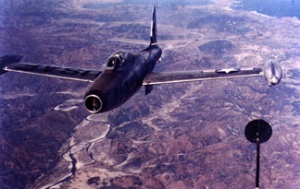
An F-84 aligning with the drogue. Notice how far off center the pilot must look to line up the probe with the basket. Any turbulence would make this essentially impossible.
Single Point Probe
Boom and Receptacle
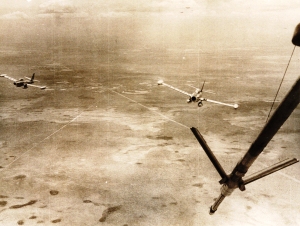
High over West Texas, two F-84Gs of the 31st Fighter Escort Wing pull in behind a waiting KB-29P during Operation Fox Peter One. Note the opened receptacle on the upper surface of the left wing.
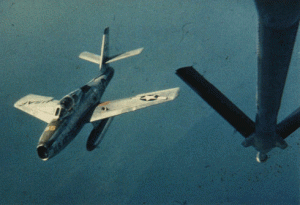
An F-84 banks off to the right after refueling from a KC-97. Note the opened receptacle and drop tanks.
F-106 Refueling
The Convair F-106 Delta Dart was the primary all-weather interceptor aircraft for the United States Air Force from the 1960s through the 1980s. Designed as the so-called “Ultimate Interceptor”, it has proven to be the last dedicated interceptor in USAF service to date. It was gradually retired during the 1980s. In this picture, a threesome of Darts take on fuel from a KC-135.
RF-84 Refueling from KC-135A
A pair of RF-84 Thunderjets refuel from a KC-135A Stratotanker. The RF-84 used a single point refueling probe that mated with the KC-135’s Boom-to-drogue adapter (BDA). This is in contrast to earlier F-84 models that refueled their wingtip tanks separately (each had its own probe fixed to the tip of the tank).
